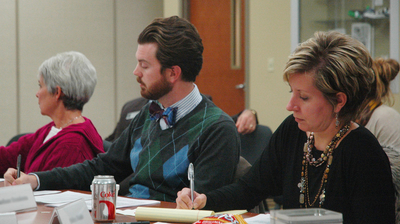Make better decisions using Exploratory Round Robin
You can make better decisions about complicated proposals by using the Exploratory Round Robin. This method combines the best of Robert’s Rules and the best of consensus methods.
The chair or a member says, “I move that we discuss this proposal using the Exploratory Round Robin.” If the body agrees, it means that members have waived their right to offer motions or amendments during the first round of discussion, in order to discover the entire range of concerns, questions, and ideas held by the members. Action comes later.
This makes it easy to see where the “sticking points” are, and to see what line of approach would be most beneficial. It also solves two problems with the Robert’s Rules of Order system of motions and amendments (see below).
How to Use the Exploratory Round Robin
- When you have a complex issue to discuss, it is helpful if members review it in advance to think about the issue and mentally prepare.
- At the meeting, staff presents the issue and their recommendation.
- The chair then goes around the room, asking each person in turn to make their comments. Members describe what they see as positive, what they see as negative, and their questions. We recommend that everyone have a pencil in hand, to be ready with questions or points when their turn comes.
- Staff note the comments on a whiteboard, computer or flipchart, using this diagram, so everyone can see them. If someone repeats an earlier comment, a hashmark is added to that comment.
- Members may pass, and speak at the end of the round if desired.
- No one may speak a second time until everyone who wishes to do so has spoken once.
- No one makes any motions during this round. It is purely to gather information.
- The chair does not answer questions or make comments during the round, but waits until the end to provide comments. This can be a challenge for the chair, but it is necessary!
- After the first round, the staff answer questions that were raised.
- The group can then hold another round, or engage in open discussion, as the group chooses.
- The chair then summarizes comments and observations and may suggest the next step. Alternatively, if the group is ready, a member may propose a motion, which may be
- To approve the proposal.
- To amend the proposal.
- To refer the item back to a committee or staff for further study, to report back on a given day.
- To postpone a decision on the item until the next meeting.
Any such motion is processed using the normal decision-making methods of your organization.
Table for Exploratory Round Robin
Advantages of the Exploratory Round Robin
This method of discussion enables the group to collect everyone’s views BEFORE moving into the action phase of the meeting. It also allows the staff to answer questions and concerns in an efficient way. Often it becomes quite clear that the group is ready, or not ready, to move ahead.
This method also avoids two problems that exist with the Robert’s Rules system of motions and amendments, namely:
- Once a member has proposed an amendment, the group must discuss that amendment, which may not be the best topic for the group to address. Sometimes it is better to tackle the larger issue of the main motion before taking on amendments.
- Once a member has proposed an amendment, no one else may speak on the main motion until the amendment is processed. This can deprive some of the members of their opportunity to speak on the main motion.
A group that is willing to use the Exploratory Round Robin will find that its meetings are much more effective than the usual “back-and-forth” of meeting discussion.



